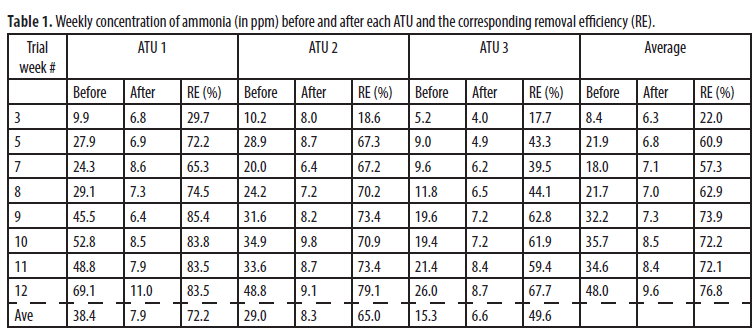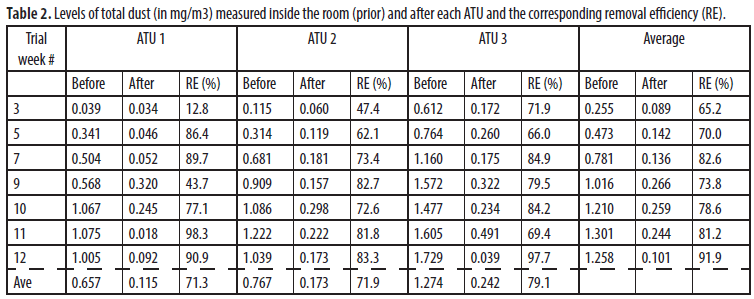



Evaluation of a Commercial-Scale Air Treatment System
A commercial scale bio-trickling air treatment unit was effective in reducing the levels of ammonia, dust and odour from growing and finishing rooms by 77, 92 and 75 per cent, respectively, report B. Predicala, A. Alvarado, M. Girard, M. Belzile, S. Lemay and J. Feddes of the Prairie Swine Centre in in 2012-2013 annual report.

Summary
An air cleaning technology based on biotrickling filtration developed in previous phases of the project was scaled up and tested at the PSC swine grower-finisher facility.
Results showed that the air treatment units were effective in reducing the levels of ammonia, dust and odour from the airstream at the exhaust of the grow-finish rooms by about 77 per cent, 92 per cent and 75 per cent, respectively.
Further work is needed to optimise the operation of these units in terms of water usage and to assess its year-round performance.
Introduction
Animal housing can emit substantial amounts of aerial contaminants such as odorous compounds, ammonia, hydrogen sulphide, airborne particulates, and pathogens. Since total removal of ammonia and odour is not possible within the confined animal space, the remaining option is to remove these contaminants from the exhaust air.
Among all air cleaning technologies, biotrickling filters are considered to be the next development for animal housing since they are easier to manage and are smaller in size than other exhaust air filtration technologies. Various configurations of biotrickling filters and bioscrubbers have been studied and showed a very good potential for controlling emissions from pig buildings. A number of operating conditions have been specified for biotrickling filters. Design values have been suggested for bed height, bed cross-sectional area, packing nominal size, empty bed residence time (EBRT), pressure drop, air temperature, liquid recycle rate, pH of the recycled liquid, and some typical control parameters. However, further work is needed in order to realise the best design that will perform effectively when installed in actual swine production facilities.
* "Air treatment units were effective in reducing the levels of ammonia, dust, and odour from grower-finishing rooms by about 77, 92 and 75 per cent, respectively." |
The main goal of this study was to develop an air cleaning technology that will reduce the offensiveness of the exhaust air from a swine grower-finisher facility.
Initial phases of this project were conducted in collaborating research institutions in Quebec to design and develop the air treatment unit (ATU) and to determine their optimum operating parameters in laboratory scale tests.
This part of the study conducted at PSC utilized the outcomes from the previous phases as basis for designing a commercial-scale ATU, which was evaluated in the PSC swine barn for its effectiveness in reducing ammonia, dust and odour emissions.
Results and Discussion
Experimental set-up

Figure 1 shows the conceptual and actual experimental set-up for this study. Three identical air treatment units (ATUs) were installed outside of three grow-finish rooms at PSC barn; the exhaust air from each room was ducted to each ATU and passed through the biotrickling filter inside each unit. Monitoring equipment and sensors were installed in the rooms and in each unit to collect data on gas and dust levels, environmental parameters, as well as operational parameters such as airflow rates and water consumption.
For this experiment, each individual unit was a replicate for two treatments (prior and after the ATU; non treated and treated air), hence, completion of this trial yielded three replicates.
Effect on ammonia concentration
Table 1 shows the weekly average ammonia (NH3) concentration before (inside the room) and after each air treatment unit.
Over the 12-week period, levels of ammonia inside the room ranged from 5.2ppm to 69.1ppm, while the levels after the treatment units ranged from 4.0ppm to 11.0ppm. The difference in ammonia levels before and after the unit was statistically significant (p<0.0001), which means that the air filtration unit was able to reduce significantly levels of ammonia in the exhaust airstream before being released to the environment.
It was also observed that the effectiveness of the ATU in reducing ammonia levels increased over time, i.e. on average, from 22 per cent reduction on week 1 to 77 per cent on week 12. This implies that the air filtration units worked effectively even at the start of the trial; however, the reduction in ammonia levels during the initial part of the trial was not that high because the incoming ammonia levels were relatively low compared to the latter part of the trial when pigs were nearly market weights and ammonia levels inside the room tended to be very high, thus, resulting to higher ammonia reduction.

Effect on dust and odour concentration
Levels of total dust before and after the air treatment units are shown in Table 2. Significant reduction (p<0.0001) in dust levels was observed after the exhaust air had passed through the treatment units. On average, dust concentration before the treatment units ranged from 0.255 to 1.301mg cubic metre, which were reduced to about 0.089 to 0.266mg per cubic metre after the units.
Similar to ammonia, dust levels after the treatment units were not significantly different (p=0.183) over the seven monitored weeks; however, dust levels inside the rooms (before the units) increased significantly (p<0.0001) with time. This has resulted to higher dust reduction achieved at the latter part of the trial when pigs were nearing market weights.
Maximum dust reduction was about 92 per cent, which was achieved on week 12 while the least reduction was about 65 per cent during week 3.


The impact of the air treatment units on odour concentration was not as readily evident compared to ammonia and dust, though statistically significant reduction (p=0.017) in overall odour levels was observed after passing through the treatment units. On average, odour concentration inside the room (before treatment) was about 815 ± 419 OU per cubic metre and was reduced to about 553 ± 208 OU per cubic metre after the air treatment units.
Water consumption
On average, the air treatment units consumed about 537.5 ± 113.3 litres of water per day; ATU 1 had the highest (663.0L per day) while ATU 3 had the least (442.9L per day). Wide variations in water consumption between ATUs can be attributed to the differences in frequency of replenishing the water in each particular unit, i.e., draining about 2 inches depth of water from the unit and then adding the same volume, to maintain the water electrical conductivity below 7.5 μS.
Throughout the trial, the water in ATU 1 was replenished 16 times compared to 11 times for ATU 3; this could be related to ammonia removal because as shown in Table 1, ATU 1 had the highest ammonia removal efficiency while ATU 3 had the least.
Periodically draining the contaminated water and then adding fresh water into the ATU was necessary to prevent the water from getting saturated, which consequently can adversely impact the biofilm activity on the biotrickling filter media, thereby reducing the contaminant removal efficiency of the system.
Conclusions
Based on the findings from this trial, the following conclusions can be made:
- The biotrickling air treatment units installed at the exhaust of swine grow-finish rooms were effective in reducing the levels of ammonia, dust, and odour by about 77 per cent, 92 per cent and 75 per cent, respectively.
- The biotrickling units were able to reduce the levels of ammonia even at the initial stage of the trial, with the ammonia levels after the filter almost remaining the same throughout the trial. Hence, the percent reduction in ammonia increased as the initial ammonia concentration before the filter increased.
- No clear diurnal pattern in ammonia reduction from the air treatment units was observed.
- Water consumption tended to increase as the biotrickling units remove more contaminants from the air.
- The biotrickling air treatment units had no adverse or beneficial impact on the performance of pigs in the room.
Acknowledgements
Strategic funding provided by the Saskatchewan Pork Development Board, Alberta Pork, Manitoba Pork Council and the Saskatchewan Ministry of Agriculture. The authors would like to acknowledge the Canadian Swine Research and Development Cluster (CSRDC) for the fi nancial support to this research project.
August 2013








